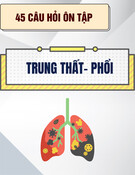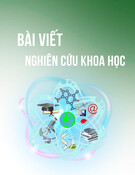
HUE JOURNAL OF MEDICINE AND PHARMACY ISSN 3030-4318; eISSN: 3030-4326 171
Hue Journal of Medicine and Pharmacy, Volume 14, No.6/2024
Main features and isolation technique mesenchymal stem cells from
wharton’s jelly
Vo Thi Hanh Thao1,2*, Nguyen Phuong Thao Tien1,2, Nguyen Van Mao1, Tran Nam Dong1,
Nguyen Thi Hieu Dung3, Sara Cruciani4, Margherita Maioli4
(1) Department of Histology, Embryology, Pathology and Forensic medicine,
University of Medicine and Pharmacy, Hue University
(2) Cells and tissue preservation unit, University of Medicine and Pharmacy Hospital
(3) Department of Physiology, University of Medicine and Pharmacy, Hue University
(4) Department of Biomedical Science, Sassari University, Italia
Abstract
Background: Wharton’s jelly-derived mesenchymal stem cells are highly homogeneous cells population,
easily expanded, especially they can bring potential applications. However, their yield depends on the
method of cells extraction conducted. Our research includes two purposes: 1/Procedure for isolating
and differentiating mesenchymal stem cells from Wharton’s jelly, 2/Determining the main features of
mesenchymal stem cells isolated from Wharton’s jelly. Materials and methods: Umbilical cords (UCs) were
harvested from the department of Pediatrics at Sassari Hospital, Italy, from healthy full-term pregnant women
who did not undergo cesarean section. After isolating Wharton’s jelly from UCs, the samples were cultured
in a medium containing DMEM 78%, Serum 18%, L-glutamine 2%, Pen/strept 2%. The fibroblast-like cells
obtaining after isolation were identified by markers on the surface which are special markers of mesenchymal
stem cells. Besides, they were cultured to differentiate into osteocytes, chondrocytes and adipocytes. After
differentiation, we used special chemicals to recognize each of line. Results: After 2 weeks, fibroblast-like
cells started to attach to bottom of the flasks. They can differenciate into osteocytes, chondrocytes and
adipocytes. The majority of isolated Wharton’s jelly-mesenchymal stem cells (WJ-MSCs) population showed
positivity for CD34 and CD117 surface markers, while a little percentage of cells showed positivity for CD45
marker. The 95.8% of all stem cells analyzed (CD34+/CD117+) were alive. Conclusions: Fibroblast-like cells
isolating from Wharton’s jelly which can differenciate into adipocytes, osteocytes, chondrocytes and show
positivity for CD34, CD117 are mesenchymal stem cells.
Key words: Mesenchymal stem cells (MSCs), umbilical’s cord, Wharton’s jelly, CD34, CD45, CD117.
Corresponding Author: Vo Thi Hanh Thao, email: vththao@huemed-univ.edu.vn
Received: 10/5/2024; Accepted: 24/11/2024; Published: 25/12/2024
DOI: 10.34071/jmp.2024.6.24
1. BACKGROUND
Stem cells derived from umbilical cord have
significant potential applications in regenerative
medicine and disease treatment. They includes three
main types: (1) Mesenchymal stem cells (MSCs):
found in Wharton’s jelly, these cells can differentiate
into bone, cartilage, fat, and other tissues. Therefore,
they can applied for repairing damaged tissues and
treating immune disorders. (2) Hematopoietic stem
cells (HSCs): found in cord blood, they can generate
blood cells such as red blood cells, white blood cells,
and platelets, commonly used in treating blood-
related diseases like leukemia and anemia; (3)
Epithelial stem cells: located in the umbilical cord
lining, these cells are promising for regenerating
skin, cornea, and connective tissues. WJ-MSCs are
highly homogeneous population of cells, a unique
feature of somatic stem cell populations [1].
WJ-MSCs differ from other umbilical cord-derived
stem cells in several key aspects. Firstly, related to
origin: They are derived from the connective tissue
in Wharton’s jelly, while HSCs come from cord
blood, and epithelial stem cells are sourced from the
umbilical cord lining. Secondly, about differentiation
potential: WJ-MSCs can differentiate into a wide
range of cells, including bone, cartilage, fat, muscle,
and nerve cells, whereas HSCs primarily form blood
cells, and epithelial stem cells focus on regenerating
skin and connective tissues. Thirdly, related to
immunological properties: WJ-MSCs have superior
immunomodulatory properties, making them less
likely to trigger immune rejection [2], unlike HSCs,
which require HLA matching for transplantation.
Especially, about applications: WJ-MSCs are widely
used in regenerative medicine to treat neurological,
cardiovascular, and musculoskeletal diseases, while






























